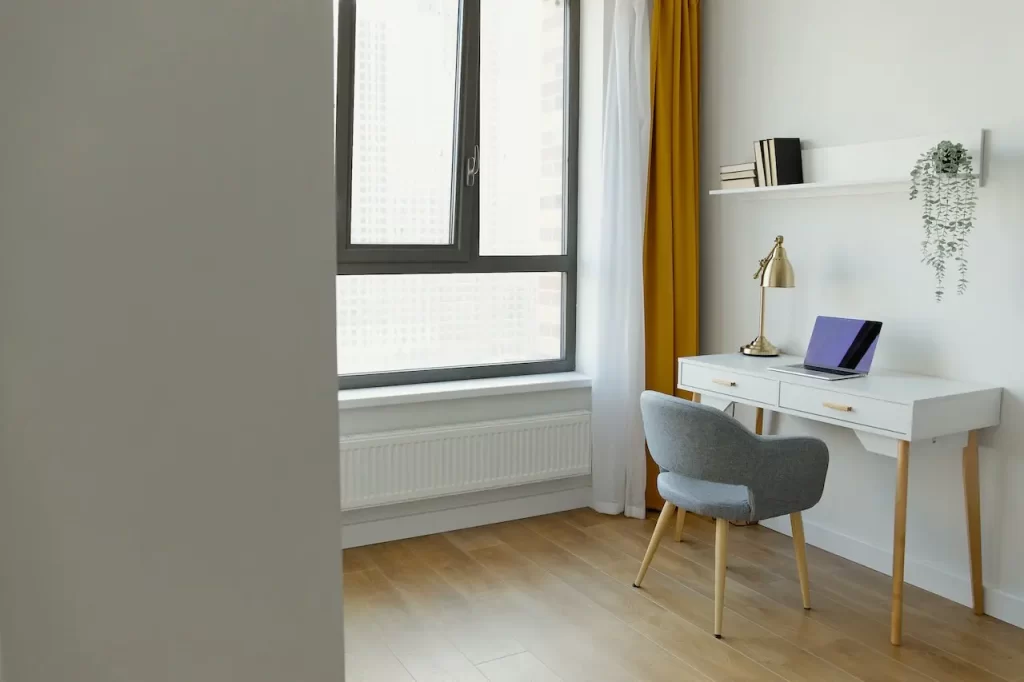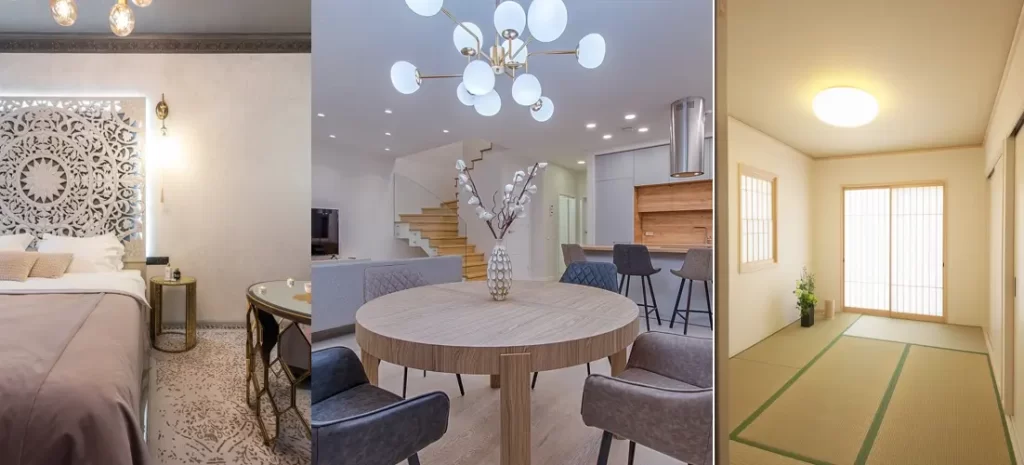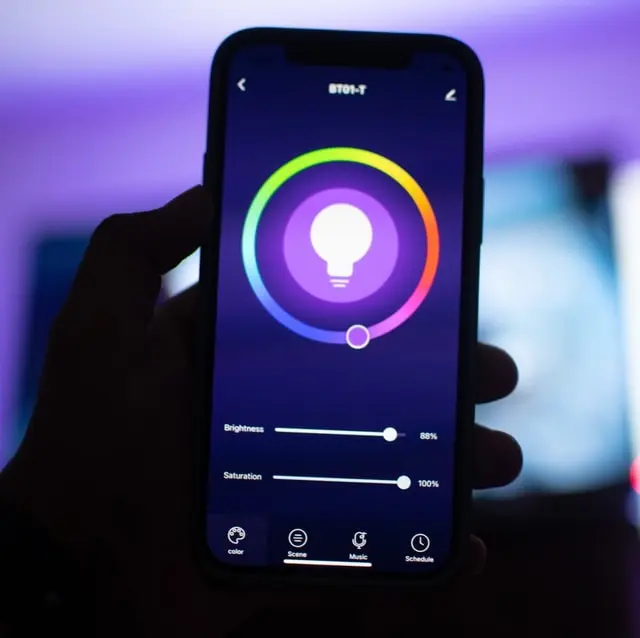
Bedroom lighting can be a tricky factor to get right. Your bedroom lighting should serve not just resting purposes but also working purposes – without both conflicting with each other.
Your body needs daylight during the day for alertness and productivity, but the light it needs at night is very different.
Here, I cover 11 tips on how to set up lighting in your bedroom office. For a comprehensive list of tips to help you design a multifunctional bedroom office, read this other article where I cover everything from setting up your desk tactically to using portable tools and maximizing ergonomics, storage, and mental focus.
1. Use both cool and warm lighting
A common mistake people make, when they work in their bedrooms, is that they only use cool lighting and neglect warm lighting.
Cool lighting is lighting that appears cool white and is great for productive activity (color temperature of 3500K and above). It is proven to help with concentration and is used in schools and offices. However, cool lighting is not the lighting that will send restful signals to your body and tell it to relax after work. Being exposed to cool lighting in the evenings can mess up your circadian rhythm.
If you set up an office in your bedroom, you will need both warm and cool lighting. Make sure you have both.
Warm lighting is necessary for bedrooms. Warm light is the type of lighting we need to wind down and fall asleep at night.
Warm lighting appears slightly yellowish, coming from bulbs that have a color temperature between 2000K and 3000K. Warm light emulates the color of sunset and tells your internal clock that it is time to sleep.
Whether it is in your recessed lights, ceiling lights, or lamps, you need some amount of warm lighting in your bedroom.
If you want to avoid the hassle of conflicting use cases, it is ideal to work in a separate room from your bedroom. Then, you will not be inconvenienced and concerned with two separate ways of lighting a room.
2. Delineate different zones of lighting in your bedroom office
Light different parts of your bedroom differently. The different types of lighting you use can differentiate your desk (use cooler lighting) against areas such as your bed and meditation zone (use warmer lighting).
You can get creative in terms of delineating different zones of lighting.
To mark the different areas of your bedroom office, you can use various sources of lighting such as desk lamps, floor lamps, or LED light strips.
If you use smart bulbs, you can toggle between different light settings as these bulbs are paired with your smartphones. Hence, you can change the color temperature of different bulbs at any time, creating totally personalized ways of lighting up different areas of your bedroom office.
3. Create layered lighting for your bedroom office
Since your bedroom office is multifunctional, it is beneficial that you use layered lighting. Layering light gives you more control over how a space is lit, since you mix and match different types of lighting to fulfill the purposes of that room.
Your bedroom office can be layered with multiple sources of light.
- Task lighting: Light that illuminates specific tasks you need to perform
- Ambient lighting: The general lighting of a room that gives it a sense of warmth and depth
- Accent lighting: Used to highlight particular decorative objects and features within a room
Task lighting is the use of specific light sources to support the tasks you are performing. When you work at your desk, use task lighting from your desk lamp to function at maximum comfort and capacity.
Accent lighting, coming from sources such as picture lights and wall sconces, is lighting that gives your bedroom its visual appeal and character.
Before you fall asleep, ambient light in a warm color temperature will help create a personal and intimate atmosphere.
While it is a good idea to create layered lighting, a word of caution is that you should not overdo the lighting in your room. It is good to keep your bedroom office minimalist.
Thus, you want to use lights that take up less space, or lights that are less distracting. Avoid hanging lights if they are within your field of vision when you work at your desk. You want to reduce visual clutter and ensure your lights do not take up precious space in a small room.
For example, if you are using pendant lights, they look best when hung above the bed and on high ceilings. Hanging them elsewhere may be distracting. You want to avoid open designs that give off too much brightness. In comparison, flush-mount ceiling lights provide enough light without being too distracting as a light fixture.

This article was originally published on unboundist.com. If it is now published on any other site, it was done without permission from the copyright owner.
4. Use smart bulbs to customize lighting for multiple uses
Since you are spending a lot of time in your bedroom office (working + resting), it is beneficial to customize your lighting beyond what static bulbs can offer.
Smart bulbs can be controlled to deliver lighting of varying colors and intensities. These bulbs can be controlled remotely, using Bluetooth connections, remote controls, and home assistants like Alexa, Google Assistant, and Apple HomeKit. You can change your lighting preferences using simple voice commands.
This is great functionality for the bedroom office since you are using one space for many purposes.
With smart bulbs, you can change the colors and intensities of your lighting at any time of the day. You can set contrasting moods for work and non-work.
By changing the colors of your lights, you can fine-tune and program your mental states at different times of the day.
In another article, I discussed the different color temperatures and intensities of lighting suited for a range of tasks such as learning, concentration, and creativity tasks.
One recommendation for smart LED bulbs is the LIFX 1100-Lumen, which is a really popular option amongst smart bulb users due to its energy efficiency and light intensity. It works with Amazon Alexa to support dimming, shades of white, and various color settings through voice control.

5. Be intentional about where you place your lights
While it is good to light up your bedroom office from all angles, it is wise to position your light sources intentionally.
In terms of task lights used for specific tasks, you want to ensure they give you the brightness you need without giving an annoying glare.
Glare is the discomfort caused by a light intensity that our eyes experience. If a light source is too bright, it is beyond what the eyes can adapt and adjust well to. This leads to squinting and eye strain.
If you have a window, it is best to locate your desk by your window in order to receive the benefits of natural sunlight. But position it at an angle that does not cause glare on your monitor screen.
In a small bedroom, you need to consider where your light is coming from. If you have a floor or wall lamp behind you as you work, it can create glare on your monitor and hurt your eyes.
Generally, it is best to position your light sources at a 90-degree angle to your screens.
6. Control excess light and glare
If you cannot rearrange your furniture or change the position of your light sources, there are ways to tackle the excess lighting.
One simple way to tackle excess light coming in from your window is to use blackout curtains.
Blackout curtains allow you to get the best of both worlds. After you get natural light during the day, you can close these curtains to completely block out light during the nighttime. This is going to help you to sleep better. With blackout curtains, your bedroom office can be close to pitch black at night, and even in broad daylight if you want it to be.
So if you want to eliminate natural light, you can close your curtains during the day. Then, add light sources back into your bedroom where necessary. This allows you to fully control and customize your bedroom lighting by adding the types of layered lighting we have discussed.
- An alternative to blackout curtains is window tape, which can be used to duct tape your windows and doors. Tape the edges to prevent cracks of light from entering your room.
Side note: An additional benefit is that blackout curtains can significantly reduce the sound coming into your bedroom office. With reduced noise levels, you will be less distracted during the day and sleep better at night.
7. Use lampshades
Avoid using lamps without shades. Bare bulbs may look sleek and aesthetically pleasing without shades, but they are meant to be placed in certain spots (high above eye level, dark closet) that you will not look directly at.
Thus, lamp shades are good practice for bedroom lighting. In fact, lamp shades are more important in a bedroom office, since you will likely use multiple sources of light (to mark different work/rest areas, give different color temperatures, serve different purposes, etc).
Lights at your desk, on your floor, and on your walls should contain shades that soften up the lighting.
Lamp shades are not only a decorative tool, but they also help to diffuse and redirect light so that your eyes can avoid harsh lighting and glare. This ensures that light does not get spilled in all directions – it only goes where it is meant to go.

8. Use desk lamps
It is important to have warm lighting in your bedroom since it is the kind of lighting that helps us fall asleep better at night.
However, if the ambient lighting of your bedroom office has a warm color temperature (such as your ceiling and recessed lights), you can always use desk lamps to set the right lighting for productive work.
Desk lamps are a good example of task lights, as they help to illuminate a certain area that you want. They are portable. Many desk lamps have adjustable arms and heads so that you can customize the height and angle of your lighting.
Use a desk lamp to light up your workspace for maximum productivity. Use the right bulbs. Studies find that cognitive ability and concentration are best under daylight bulbs, with color temperatures between 5000K and 6500K.
Besides serving as task lights, desk lamps also serve a decorative purpose – as accent lights.
They can create the right ambiance in your bedroom when used to illuminate certain objects on your shelves such as cups, books, decorative objects, and artwork.
9. Use floor lamps
Besides your desk, you can illuminate other areas of your bedroom office. Floor lamps are a great option since they can make certain seating areas and corners of your bedroom functional.
In a bedroom office, you can use floor lamps to illuminate an area for reading, reflection, or meditation. They also help decorate your space.
Floor lamps are typically a few feet tall. They are portable lighting options that you can easily rearrange, in order to customize the way you light your room.
Some floor lamps have adjustable arms and heads which can be used to change the direction of light.
10. Install wall sconces
An efficient way to use limited bedroom space, especially when you locate your office in it, is to make use of your empty walls.
Wall sconces are usually installed on either side of the bed, or used to illuminate specific areas such as reading nooks. Installed on the walls, they let you maximize floor space, so you can prevent your room from becoming too cluttered. Hence, wall sconces are especially useful in a smaller room. Besides, they are also decorative tools.
Find wall sconces with adjustable swing arms and shades, so that you can customize where the light goes without hurting your eyes.

11. Avoid blue light in the evenings
Last but not least, do your best to avoid blue light in the evenings. Blue light comes from your electronic devices, but fortunately, you can change the color temperature of your screens.
Set up blue light filters on all of your devices. Set up night mode on your mobile phone and use relatively inexpensive apps like Flux or Iris on your computer.
When it is time to wind down, your bedroom office is really meant to be just a bedroom. Work-life balance is tough enough when working from home, with all your electronics lying around, and with you working and living in the same space. Thus, you would need to change the mood and visuals.
Dim the lights, block blue light, go for a walk, shut down your computer, and keep your work out of sight when it is done.